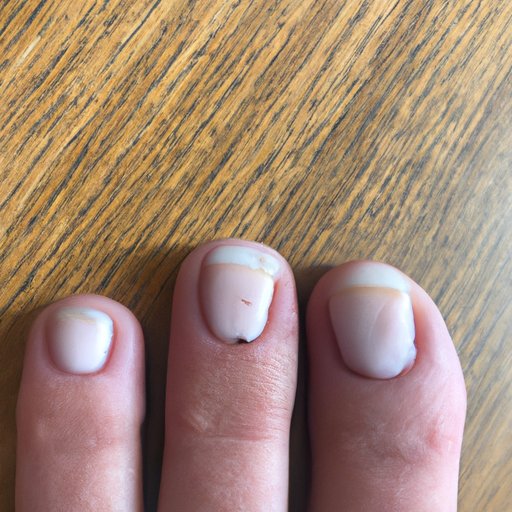Introduction
Nail fungus is a type of fungal infection that affects the nails, most commonly the toenails. It is also known as onychomycosis or tinea unguium. Nail fungus can cause changes in the appearance of the nails, such as discoloration, thickening, crumbling or even total destruction of the nail. It can also cause pain and discomfort when walking or wearing shoes.
A Visual Guide to Nail Fungus: What Does It Look Like?
Nail fungus can take on many different forms and appear in different ways. There are several types of fungus that can cause nail infections, including dermatophytes, yeasts, and molds. The most common type is dermatophyte fungus, which typically causes yellow or white spots on the nails.
Common signs and symptoms of nail fungus include discoloration of the nail, thickening or crumbling of the nail, debris under the nail, and separation of the nail from the nail bed. In more severe cases, the nail may become brittle, break easily, and even fall off.

How to Spot Nail Fungus: A Picture Guide
To help you identify nail fungus, here are some images of what it looks like.

In the image above, you can see the yellowish discoloration of the nail, which is a common sign of nail fungus. This discoloration is caused by the buildup of keratin debris under the nail.

The image above shows an example of a nail that has been affected by nail fungus. You can see the thickening of the nail, as well as the separation of the nail from the nail bed.

The image above shows a nail that has been severely affected by nail fungus. The nail is brittle and crumbling, and there is debris under the nail. This is a sign that the infection has progressed and needs to be treated right away.
All You Need to Know About Nail Fungus Symptoms
Nail fungus is a common condition that can cause a variety of symptoms. Common symptoms include discoloration of the nail (yellow, white, green, or brown), thickening or crumbling of the nail, debris under the nail, and separation of the nail from the nail bed. Some people may also experience pain and discomfort when walking or wearing shoes.
There are several risk factors for developing nail fungus, including age, smoking, poor hygiene, diabetes, and being exposed to warm, moist environments. People with weakened immune systems are also at an increased risk for developing nail fungus.
An In-Depth Look at the Signs of Nail Fungus
When it comes to diagnosing nail fungus, it is important to look for certain signs and symptoms. The most common sign of nail fungus is discoloration of the nail, which can range from yellow to white, green, or brown. Other signs include thickening or crumbling of the nail, debris under the nail, and separation of the nail from the nail bed.
It is also important to note that the nails may become brittle and break easily if the infection is left untreated. If you notice any of these signs, it is important to seek medical attention right away.
Nail Fungus: Causes, Symptoms and Treatment Options
Nail fungus is caused by a fungal infection of the nails. The most common cause is exposure to warm, moist environments, such as public showers or pools. Other risk factors include age, smoking, poor hygiene, diabetes, and weakened immune systems.
If you suspect that you have nail fungus, it is important to seek medical attention right away. Your doctor will be able to diagnose the infection and recommend the best treatment option for you. Treatment options include antifungal medications, laser therapy, and topical treatments.
Nail Fungus: What Does It Look Like and How Can You Treat It?
Nail fungus is a common fungal infection that can cause discoloration and thickening of the nails. It is important to be aware of the signs and symptoms of nail fungus, as it can be hard to spot at first. Common signs include discoloration of the nail, thickening or crumbling of the nail, debris under the nail, and separation of the nail from the nail bed.
If you suspect that you have nail fungus, it is important to seek medical attention right away. Treatment options include antifungal medications, laser therapy, and topical treatments. It is also important to practice good hygiene and keep your feet clean and dry to prevent the spread of nail fungus.
Conclusion
Nail fungus is a common fungal infection that can cause discoloration and thickening of the nails. It is important to be aware of the signs and symptoms of nail fungus so that you can get prompt treatment. If you suspect that you have nail fungus, it is important to seek medical attention right away. Treatment options include antifungal medications, laser therapy, and topical treatments.
To prevent the spread of nail fungus, it is important to practice good hygiene and keep your feet clean and dry. Wear protective footwear in public areas, such as showers and swimming pools, and avoid sharing nail clippers or other grooming tools.


